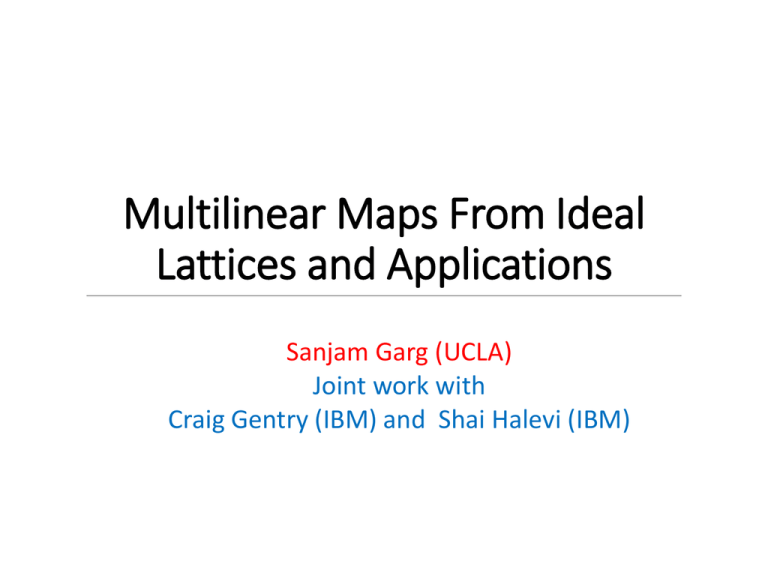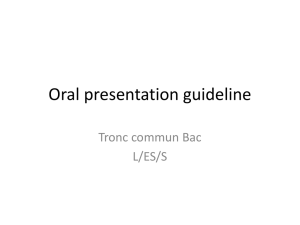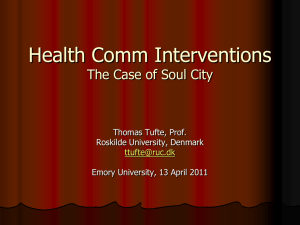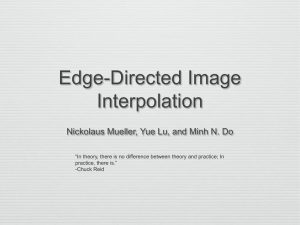Multilinear Maps From Ideal Lattices + Applications
advertisement

Multilinear Maps From Ideal Lattices and Applications Sanjam Garg (UCLA) Joint work with Craig Gentry (IBM) and Shai Halevi (IBM) Outline Bilinear Maps: Recall and Applications Motivating Multilinear maps Our Results Definitions of Multi-linear Maps Classical Notion Our Notion Our Construction Security Cryptographic Bilinear Maps (Weil and Tate Pairings) Recalling Bilinear Maps and its Applications: Motivating Multilinear Maps Cryptographic Bilinear Maps Bilinear maps are extremely useful in cryptography lots of applications As the name suggests allow pairing two things together Bilinear Maps – Definitions Cryptographic bilinear map Groups 𝐺1 and 𝐺2 of order 𝑝 with generators 𝑔1 , 𝑔2 = 𝑒 𝑔1 , 𝑔1 and a bilinear map 𝑒 ∶ 𝐺1 × 𝐺1 → 𝐺2 such that ∀ 𝑎, 𝑏 ∈ 𝑍𝑝 , 𝑒 𝑔1𝑎 , 𝑔1𝑏 = 𝑔2𝑎𝑏 Instantiation: Weil or Tate pairings over elliptic DDH is easy curves. Given 𝑔1𝑎 , 𝑔1𝑏 , 𝑇 ? CDH is hard 𝑎𝑏 𝑇 = 𝑔 1 Given 𝑔1𝑎 , 𝑔1𝑏 hard 𝑎 𝑏 𝑒 𝑔 1 , 𝑔1 = 𝑒 𝑔1 , 𝑇 𝑎𝑏 to get 𝑔1 Bilinear Maps: ``Hard” Problems 3-party Decisional Diffie-Hellman: Given 𝑔1 , 𝑔1𝑎 , 𝑔1𝑏 , 𝑔1𝑐 ∈ 𝐺 hard to distinguish 𝑔1𝑎𝑏𝑐 from Random Bilinear Diffie-Hellman: Given 𝑔1 , 𝑔1𝑎 , 𝑔1𝑏 , 𝑔1𝑐 ∈ 𝐺 hard to distinguish 𝑎𝑏𝑐 𝑎𝑏𝑐 𝑒 𝑔1 , 𝑔1 = 𝑔2 from Random Application 1 Non-Interactive Key Agreement [DH76] 𝑔1𝑎 𝑎 𝑔1𝑏 𝐾 = 𝑔1𝑎𝑏 𝑏 Easy Application: Tri-partite key agreement [Joux00]: Alice, Bob, Carol generate 𝑎, 𝑏, 𝑐 and broadcast 𝑔1𝑎 , 𝑔1𝑏 , 𝑔1𝑐 . They each separately compute the key 𝐾 = 𝑒 𝑔1 , 𝑔1 𝑎𝑏𝑐 What if we have more than 3-parties? [BS03] Application 2 Non-Interactive Zero Knowledge [BMF88] Witness for statement being true Common reference string : 𝐴&$%3(𝑧? Statement : 𝑥 Proof: 𝜋 What if Prover we had Bilinear maps from some other assumption? Verifier Soundness: Zero-knowledge: Only know constructions are from Bilinear Maps[GOS06] and Statement Nothing but truth revealed Trapdoor permutation[FLS90] . is true Application 3 PKE with Enhanced Capabilities Identity Based Encryption [Sha84] Boneh and Franklin using bilinear maps [BF01] More general notion – Attribute Based Encryption [SW05] Application 3 Attribute-Based Encryption [SW05] What if we had multilinear maps? MSK OR Chancellor AND TAU SK “Tel-Aviv University” “Professor” Professor PK Key Authority OR Chancellor TAU AND Professor How general can SK’this policy be? “Tel-Aviv University” “Grad-student” Bottom line: Very few policies such as formulas are known to be 10 realizable. Other Applications Traitor-Tracing (with small ciphertexts)[BSW06] Efficient Signature Schemes [BLS04] Efficient Broadcast Encryption Attribute based signatures Blind Signatures/Anonymous Credentials Structure Preserving Signatures And many more…. There is a conference on Pairing based Cryptography What if we had multilinear map? [BS03] Outline Bilinear Maps: Recall and Applications Motivating Multilinear maps Our Results Definitions of Multi-linear Maps Classical Notion Our Notion Our Construction Security Our Results Candidate approximate Constructions constructions of multiof multi-linear maps linear maps (Public parameters hide secrets) Use these to get 𝑛-party non-interactive Diffie Hellman NIZKs from lattice assumptions Attribute based encryption for general circuits [GGH12, SW12] Witness Encryption [GGSW12] Insufficient for [Rot12] counterexample Every bit encryption remains secure even when encryption of the secret key is given out Application 4 Witness Encryption Statement : 𝑥 Witness for statement 𝑥. 𝑐 𝑚 Encrypter Receiver Soundness: Statement is false ⟹ Semantic Security Outline Bilinear Maps: Recall and Applications Motivating Multilinear maps Our Results Definitions of Multi-linear Maps Classical Notion Our Notion Our Construction Security Cryptographic Multi-linear Maps Definitions: Classical notion and our Approximate variant Multilinear Maps: Classical Notion Cryptographic n-multilinear map (for groups) Groups 𝐺1, … , 𝐺𝑛 of order 𝑝 with generators 𝑔1, … , 𝑔𝑛 Family of maps: 𝑒𝑖,𝑘 : 𝐺𝑖 × 𝐺𝑘 → 𝐺𝑖+𝑘 for 𝑖 + 𝑘 ≤ 𝑛, where 𝑎𝑏 𝑒𝑖,𝑘 𝑔𝑖𝑎 , 𝑔𝑘𝑏 = 𝑔𝑖+𝑘 ∀𝑎, 𝑏 ∈ 𝑍𝑝 . And at least the ``discrete log” problems in each 𝐺𝑖 is ``hard’’. And hopefully the generalization of 3-party DH Getting to our Notion Our visualization of (traditional) Bilinear Maps Step by step I will make changes to get our notion of Bilinear Maps At each step provide Extension to Multi-linear Maps Bilinear Maps: Our visualization 𝑍𝑝 𝐺1 𝐺2 1 𝑔11 𝑔21 2 ⋮ 𝑝 𝑔12 ⋮ 𝑝 𝑔1 𝑔22 ⋮ 𝑝 𝑔2 Bilinear Maps: Our visualization Sampling 𝑍𝑝 𝐺1 𝐺2 1 𝑔11 𝑔21 2 ⋮ 𝑝 𝑔12 ⋮ 𝑝 𝑔1 𝑔22 ⋮ 𝑝 𝑔2 It was easy to sample uniformly from 𝑍𝑝 . Bilinear Maps: Our visualization Equality Checking 𝑍𝑝 𝐺1 𝐺2 1 𝑔11 𝑔21 2 ⋮ 𝑝 𝑔12 ⋮ 𝑝 𝑔1 𝑔22 ⋮ 𝑝 𝑔2 Trivial to check if two terms are the same. Bilinear Maps: Our visualization Addition 𝑍𝑝 𝐺1 𝐺2 1 𝑔11 𝑔21 2 ⋮ 𝑝 𝑔12 ⋮ 𝑝 𝑔1 𝑔22 ⋮ 𝑝 𝑔2 𝑔13 Bilinear Maps: Our visualization Multiplication 𝑍𝑝 𝐺1 𝐺2 1 𝑔11 𝑔21 2 ⋮ 𝑝 𝑔12 ⋮ 𝑝 𝑔1 𝑔22 ⋮ 𝑝 𝑔2 Bilinear Maps: Sets (Our Notion) 𝐺1 𝑍𝑝 𝐺2 1 𝑆01 𝑔11 𝑆11 𝑔21 𝑆21 2 ⋮ 𝑝 𝑆02 𝑔12 ⋮ 𝑝 𝑔1 𝑆12 𝑔22 ⋮ 𝑝 𝑔2 𝑆22 𝑝 𝑆0 𝑆0 Level-0 encodings 𝑝 𝑆1 𝑆1 𝑝 𝑆2 𝑆2 Multilinear Maps: Our Notion Finite ring 𝑅 and sets 𝑆𝑖 ∀𝑖 ∈ 𝑛 : ``level-𝑖 encodings” Each set 𝑆𝑖 is partitioned into 𝑆𝑖𝑎 for each 𝑎 ∈ 𝑅: ``level-𝑖 encodings of 𝑎”. Bilinear Maps: Sampling (Our Notion) 𝐺1 𝑍𝑝 1 𝑆01 2 ⋮ 𝑝 𝑆02 𝑝 𝑆0 𝑆0 𝑔11 𝐺2 𝑆11 𝑔21 𝑆21 1 𝑆1 2 𝑆2 I should sample 𝛼 2 to 2 2 be efficient 2 𝑔1𝑆 𝑆such 𝑔2∈ 𝑆𝑆𝑎2 for a 1 ← that 𝛼 0 0 ⋮ ⋮ not be uniform uniform 𝑎. It may 𝑎 𝑝 𝑝 𝑝 in 𝑆 or 𝑆 . 𝑝 0 0 𝑔 𝑔 𝑆1 𝑆2 It was easy to sample uniformly from 𝑍𝑝 . Multilinear Maps: Our Notion Finite ring 𝑅 and sets 𝑆𝑖 ∀𝑖 ∈ 𝑛 : ``level-𝑖 encodings” Each set 𝑆𝑖 is partitioned into 𝑆𝑖𝑎 for each 𝑎 ∈ 𝑅: ``level-𝑖 encodings of 𝑎”. Sampling: Output 𝛼 such that 𝛼 ∈ 𝑆0𝑎 for a unifrom 𝑎 Bilinear Maps: Equality Checking (Our Notion) 𝐺1 𝑍𝑝 𝐺2 1 𝑆01 𝑔11 𝑆11 𝑔21 𝑆21 2 ⋮ 𝑝 𝑆02 𝑔12 ⋮ 𝑝 𝑔1 𝑆12 𝑔22 ⋮ 𝑝 𝑔2 𝑆22 𝑝 𝑆0 𝑆0 𝑝 𝑆1 𝑆1 Check if two values come from the same set. 𝑝 𝑆2 𝑆2 It was trivial to check if two terms are the same. Multilinear Maps: Our Notion Finite ring 𝑅 and sets 𝑆𝑖 ∀𝑖 ∈ 𝑛 : ``level-𝑖 encodings” Each set 𝑆𝑖 is partitioned into 𝑆𝑖𝑎 for each 𝑎 ∈ 𝑅: ``level-𝑖 encodings of 𝑎”. Sampling: Output 𝛼 such that 𝛼 ∈ 𝑆0𝑎 for a random 𝑎 Equality testing(𝛼, 𝛽, 𝑖): Output 1 iff ∃𝑎 such that 𝛼, 𝛽 ∈ 𝑆𝑖𝑎 Bilinear Maps: Addition (Our Notion) 𝐺1 𝑍𝑝 𝐺2 1 𝑆01 𝑔11 𝑆11 𝑔21 𝑆21 2 ⋮ 𝑝 𝑆02 𝑔12 ⋮ 𝑝 𝑔1 𝑆12 𝑔22 ⋮ 𝑝 𝑔2 𝑆22 𝑝 𝑆0 𝑆0 𝑔13 𝑝 𝑆1 𝑆1 3 𝑆1 𝑝 𝑆2 𝑆2 Multilinear Maps: Our Notion Finite ring 𝑅 and sets 𝑆𝑖 ∀𝑖 ∈ 𝑛 : ``level-𝑖 encodings” Each set 𝑆𝑖 is partitioned into 𝑆𝑖𝑎 for each 𝑎 ∈ 𝑅: ``level-𝑖 encodings of 𝑎”. Sampling: Output 𝛼 such that 𝛼 ∈ 𝑆0𝑎 for a random 𝑎 Equality testing(𝛼, 𝛽, 𝑖): Output 1 iff ∃𝑎 such that 𝛼, 𝛽 ∈ 𝑆𝑖𝑎 Addition/Subtraction: There are ops + and – such that: ∀𝑖 ∈ 𝑛 , 𝑎, 𝑏 ∈ 𝑅, 𝛼 ∈ 𝑆𝑖𝑎 , 𝛽 ∈ 𝑆𝑖𝑏 : We have 𝛼 + 𝛽 ∈ 𝑆𝑖𝑎+𝑏 and 𝛼 − 𝛽 ∈ 𝑆𝑖𝑎−𝑏 . Bilinear Maps: Multiplication (Our Notion) 𝐺1 𝑍𝑝 𝐺2 1 𝑆01 𝑔11 𝑆11 𝑔21 𝑆21 2 ⋮ 𝑝 𝑆02 𝑔12 ⋮ 𝑝 𝑔1 𝑆12 𝑔22 ⋮ 𝑝 𝑔2 𝑆22 𝑝 𝑆0 𝑆0 𝑝 𝑆1 𝑆1 𝑝 𝑆2 𝑆2 Multilinear Maps: Our Notion Finite ring 𝑅 and sets 𝑆𝑖 ∀𝑖 ∈ 𝑛 : ``level-𝑖 encodings” Each set 𝑆𝑖 is partitioned into 𝑆𝑖𝑎 for each 𝑎 ∈ 𝑅: ``level-𝑖 encodings of 𝑎”. Sampling: Output 𝛼 such that 𝛼 ∈ 𝑆0𝑎 for a random 𝑎 Equality testing(𝛼, 𝛽, 𝑖): Output 1 iff ∃𝑎 such that 𝛼, 𝛽 ∈ 𝑆𝑖𝑎 Addition/Subtraction: There are ops + and – such that: Multiplication: There is an op × such that: ∀𝑖, 𝑘 such that 𝑖 + 𝑘 ≤ 𝑛, ∀𝑎, 𝑏 ∈ 𝑅, 𝛼 ∈ 𝑆𝑖𝑎 , 𝛽 ∈ 𝑆𝑘𝑏 : 𝑎𝑏 We have 𝛼 × 𝛽 ∈ 𝑆𝑖+𝑘 . Bilinear Maps: Noisy (Our Notion) 𝐺1 𝑍𝑝 𝐺2 1 𝑆01 𝑔11 𝑆11 𝑔21 𝑆21 2 ⋮ 𝑝 𝑆02 𝑔12 ⋮ 𝑝 𝑔1 𝑆12 𝑔22 ⋮ 𝑝 𝑔2 𝑆22 𝑝 𝑆0 𝑆0 𝑝 𝑆1 𝑆1 𝑝 𝑆2 𝑆2 All operations are required to work as long as ``noise’’ level remains small. Multilinear Maps: Our Notion Discrete Log: Given level-𝑗 encoding of 𝑎, hard to compute level-(𝑗-1) encoding of 𝑎. n-Multilinear DDH: Given level-1 encodings of 1, 𝑎1, … , 𝑎𝑛+1 and a level-n encoding T distinguish whether T encodes 𝑎1 ∙∙∙ 𝑎𝑛+1 or not. Outline Bilinear Maps: Recall and Applications Motivating Multilinear maps Our Results Definitions of Multi-linear Maps Classical Notion Our Notion Our Construction Security ``Noisy” Multilinear Maps (Kind of like NTRU-Based FHE, but with Equality Testing) Our Construction We work in polynomial ring 𝑅 = 𝑍[𝑥]/𝑓(𝑥) E.g., 𝑓(𝑥) = 𝑥 𝑛 + 1 (𝑛 is a power of two) Also use 𝑅𝑞 = 𝑅/𝑞𝑅 = 𝑍[𝑥]/(𝑓(𝑥), 𝑞) Public parameters hide a small 𝑔 ∈ 𝑅𝑞 and a random (large) 𝑧 ∈ 𝑅𝑞 𝑔 defines a principal ideal 𝐼 = (𝑔) over 𝑅 The ``scalars” that we encode are cosets of 𝐼 (i.e., elements in the quotient ring 𝑅/𝐼) e.g., if |𝑅/𝐼| = 𝑝 is a prime, then we can represent these cosets using the integers 1,2 … , 𝑝 Our Construction 𝑅 = 𝑍[𝑥]/𝑓 𝑥 and 𝑅𝑞 = 𝑅/𝑞𝑅 Small 𝑔 ∈ 𝑅𝑞 defines a principal ideal 𝐼 = (𝑔) over 𝑅 + and × 𝑆01 1+ 𝐼 𝑆11 𝑆02 2+ 𝐼 𝑆12 ⋮ ⋮ 𝑐 𝑐 𝑧 𝑆21 𝑆22 𝑞 ⋮ 𝑐 𝑧2 𝑞 𝑝 𝐼, are both short𝑝then, If𝑆 𝑝𝑐 ∈ 𝐼𝑠 + 𝐼, 𝑑 ∈ 𝑡𝑆+ 𝑆2 0 1 𝑐+𝑑 𝑐𝑐 𝑑𝑑 𝑐×𝑑 + has hasthe theform form 2 ,, × 𝑧 𝑧 𝑧 𝑧 𝑧 𝑞𝑞 𝑧 𝑞𝑞 𝑆 𝑆1 and where 𝑐𝑐+×𝑑𝑑isisstill where stillshort short and𝑐𝑐+ ×𝑑𝑑 ∈∈𝑆𝑠2𝑠 + ∙ 𝑡𝑡++𝐼𝐼 0 A random (large) 𝑧 ∈ 𝑅𝑞 𝑐 should have small coefficients Our Construction (in general) In general, ``level-k encoding” of a coset 𝑠 + 𝐼 has 𝑐 the form 𝑘 for a short 𝑐 ∈ 𝑠 + 𝐼 𝑧 𝑞 Addition: Add encodings 𝑢𝑖 = as long as | 𝑖 𝑐_𝑖 |≪ 𝑞 𝑐𝑖 𝑧𝑗 𝑞 Multi-linear: Multiply encodings 𝑢𝑖 = 𝑧 𝑗𝑖 𝑞 to get an encoding of the product at level as long as 𝑖 𝑐𝑖 ≪ 𝑞 ``Somewhat homomorphic” encoding Sampling and equality check? 𝑐𝑖 𝑖 𝑗𝑖 Sampling Sampling: If 𝑐 ← 𝐷𝑖𝑠𝑐𝑟𝑒𝑡𝑒𝐺𝑎𝑢𝑠𝑠𝑖𝑎𝑛(𝑍 𝑛 ) (wider than smoothing parameter of 𝑔 but still smaller than 𝑞), then 𝑐 encodes a random coset. Why should this work? Recall 𝐼 = 𝑔 -- vector with tiny coefficients Encoding this random coset Publish an encoding of 1: 𝑦= 𝑎 𝑧 𝑞 Sampling: If 𝑐 ← 𝐷𝑖𝑠𝑐𝑟𝑒𝑡𝑒𝐺𝑎𝑢𝑠𝑠𝑖𝑎𝑛(𝑍 𝑛 ) (wide enough), then 𝑐 encodes a random coset. Don’t know how to encode specific elements Given this short 𝑐, set 𝑢 = [𝑐 · 𝑦]𝑞 𝑢 is a valid level-1 encoding of the coset 𝑐 + 𝐼 Translating from level 𝑖 to 𝑖 + 1: 𝑢𝑖+1 = 𝑢𝑖 ⋅ 𝑦 𝑞 Equality Checking Do 𝑢, 𝑢’ encode the same coset? Suffices to check - 𝑢 − 𝑢′ 𝑞 encodes 0. Publish a (level-k) zero-testing param 𝑣𝑘 = ℎ𝑧 𝑘 𝑔 𝑞 h is ``somewhat short” (e.g. of size 𝑞) To test, if 𝑢 = [𝑐/𝑧𝑘]𝑞 encodes 0, compute 𝑤 = 𝑢 · 𝑣𝑘 𝑞 = 𝑐 𝑧𝑘 ∙ ℎ𝑧 𝑘 𝑔 𝑞 = 𝑐ℎ 𝑔 𝑞 Which is small if 𝑐 ∈ 𝐼 (or, 𝑐 = 𝑐′𝑔) Re-randomizaton 𝑆0𝑠 𝑆0𝑡 𝑆0𝑠𝑡 𝑆0𝑟 𝑐𝑠 𝑐𝑡 𝑐𝑠𝑡 𝑐𝑟 This re-randomization gets us statistically close to the actual distribution [AGHS12]. Compute 𝑐𝑢 𝑢𝑠𝑡 𝑢𝑟 𝑠𝑡 𝑠= 𝑐𝑠𝑐𝑢 𝑡 𝑡 𝑆1 And encode 𝑢𝑠 = [𝑐𝑠 𝑦]𝑞, 𝑢𝑡 = [𝑐𝑡 𝑦]𝑞, 𝑢𝑠𝑡 = [𝑐𝑠𝑡 𝑦]𝑞 But then 𝑢𝑠𝑡 = 𝑢𝑠 𝑢𝑡 𝑦 𝑆1𝑠𝑡 Need to re We need to re-randomize the encoding, to break randomize these simple algebraic relations this as well. 𝑆10 𝑥0 𝑥0′ 𝑥0′′ ⋯ ⋯ ⋯ The Complete Encoding Scheme Parameters: 𝑦= 𝑎 , 𝑧 𝑞 𝑥𝑖 = 𝑏𝑖 , 𝑧 𝑞 𝑖 and 𝑣𝑘 = ℎ𝑧 𝑘 𝑔 𝑞 Encode a random element: Sample 𝑐 and set 𝑢 = 𝑐𝑦 + 𝜌𝑖 ← 𝐷𝑖𝑠𝑐𝑟𝑒𝑡𝑒𝐺𝑎𝑢𝑠𝑠𝑖𝑎𝑛𝑠 (𝑍) 𝑖 𝜌𝑖 𝑥𝑖 𝑞 Re-randomize u (at level 1): 𝑢′ = 𝑢 + Zero Test: 𝑖 𝜌𝑖 𝑥𝑖 𝑞 𝑗 Map to level 𝑘 (by multiplying by 𝑦 for appropriate j) Check if 𝑢 ⋅ 𝑣𝑘 𝑞 is small Variants Asymmetric variants (many zi’s), XDH analog 𝑦𝑖 = 𝑎𝑖 , 𝑧𝑖 𝑞 𝑥𝑖,𝑗 = 𝑏𝑖,𝑗 𝑧𝑖 𝑞 𝑖,𝑗 , 𝑣𝑘 = ℎ 𝑖 𝑧𝑖 𝑔 𝑞 Partially symmetric and partially asymmetric Statistical Zero-test security Security: Cryptanalysis Attacks 𝑦= 𝑎 , 𝑧 𝑞 𝑥𝑖 = 𝑏𝑖 , 𝑧 𝑞 𝑖 and 𝑣𝑘 = ℎ𝑧 𝑘 𝑔 𝑞 Goal: To find 𝑧 or 𝑔 Covering the basics (Not ``Trivially’’ broken) Adversary that only (iteratively) adds, subtracts, multiplies, or divides pairs of elements that it has already computed cannot break the scheme Similar in spirit to Generic Group model Without the 𝑣𝑘 - essentially the NTRU problem Attacks 𝑦= 𝑎 , 𝑧 𝑞 𝑥𝑖 = 𝑏𝑖 , 𝑧 𝑞 𝑖 and 𝑣𝑘 = Goal: To find 𝑧 or 𝑔 Algebraic and Lattice Attacks Averaging attacks Other attacks for Principal Ideals ℎ𝑧 𝑘 𝑔 𝑞 Summary Presented ``noisy” cryptographic multilinear map. Construction is similar to NTRU-based homomorphic encryption, but with an equalitytesting parameter. Security is based on somewhat stronger computational assumptions than NTRU. But more cryptanalysis needs to be done! And more applications need to be found! Thank You! Questions?








